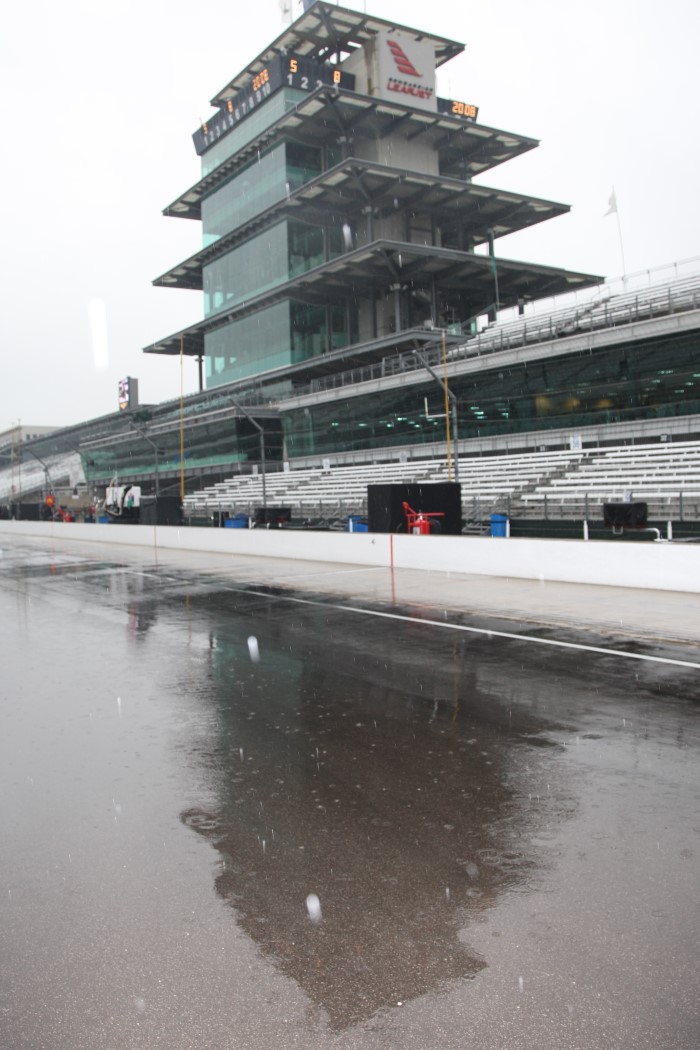Drama builds for Indy pole as rain hits again
 |
| Rain hits Indy again |
| Ron McQueeney/IRL |
For the first time since 2006, rain forced the cancellation of a second consecutive day of on-track activity at the Indianapolis Motor Speedway. The lack of track time adds to the drama and tension as teams prepare for qualifying for the Indianapolis 500.
A key moment in the month-long pursuit to become the Indianapolis 500 champion comes May 10 when drivers compete for the top 11 starting positions for the 92nd running of the 500-Mile Race, including the PEAK Motor Oil Pole Award presented by AutoZone and it’s $100,000 prize.
But, for the 11 drivers who don’t qualify on Pole Day, there’s still hope. Three times in the last 10 years, the winner has come from outside the top 11 spots.
Eddie Cheever Jr. drove to Victory Lane from the 17th starting position in 1998. Helio Castroneves won from 13th in 2002, and Dan Wheldon started 16th when he won in 2005.
“Your primary goal at this race is to win the race," said Wheldon, who led 30 laps in 2005. “You can get very caught up in qualifying, and it’s a very proud achievement for everyone on the team to be on pole for the race. You have to make a very disciplined approach to that and understand that if your car is not necessarily a pole contender, you can waste a lot of tires trying to do that."
The bigger key, according to Castroneves, Cheever and Wheldon, is to have a good race car.
“Not only was I back there (in 17th)," said Cheever, who is part of the ABC broadcast team this May. “But in the first corner, I got hit from behind and almost spun."
Despite the early setback, Cheever was able to get to the front and take his first lead on Lap 68.
“It was just one of those races where apart from a really bad first corner everything went right," Cheever said. “We didn’t have to change the car at all. Owen Snyder had done a really good job on the setup. We had one pit stop problem where I thought I was told to go, but I wasn’t, and we almost ripped the fuel tank out of the car. But the car was just good.
“I always thought it was wise to take the lead at the last possible moment and save your car, but I found myself in front. The pace was good, the car was running well, and everything just kind of fell my way."
Wheldon climbed into the top 10 by Lap 28 and into the top five on Lap 55. However, he didn’t take the lead until Lap 150.
“I had a great race car and was able to get to the front very, very quickly," said Wheldon, who also led laps in 2004 and 2006. “That’s how it works around here. In the race, you don’t necessarily have to have the fastest race car to get to the front. You need a car that handles good in traffic, because you’re not going to avoid traffic around this place. And you need something that is consistent. The track changes, the temperature changes, so it’s got to be consistent in all conditions."
Castroneves cut things the closest. He didn’t take the lead in the 2002 Indianapolis 500 until Lap 177, leading the final 24 laps on his way to becoming a two-time winner at Indy.
Even though they’ve proved it’s possible to win from the middle of the 33-car field, the drivers would prefer to start up front.
“It’s always good (to qualify the first weekend), because you don’t want to spend that next week thinking about qualifying – you want to think about racing," Castroneves said. “You want to make sure you prepare yourself for the race the next week. Whatever happens after that, you need to be able to adapt to those circumstances."
Said Cheever: “I think the front row is definitely the place to be when you’re starting the 500. Other than the fact that it’s a lot of fun to be on the front row leading up to the race, there’s less possibilities of getting caught up in somebody else’s accidents. Every row that you go back into the field, the multiple of you having a possible race-ending accident goes up dramatically."
